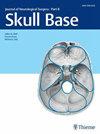中窝入路时神经导航定位内听道的可靠性
IF 0.9
4区 医学
Q3 Medicine
引用次数: 0
摘要
目的 由于中窝底部没有精确的地标,而且解剖结构经常发生变化,因此在中窝入路(MFA)过程中很难定位内听道(IAC)。我们的目的是研究神经导航系统(NNS)在中窝入路中的可靠性和实用性,并划定入路过程中有关 NNS 的具体技术注意事项。方法 对五具福尔马林固定的人体尸体(10 侧)进行了一毫米薄切片计算机断层扫描。在 MFA 过程中,在 NNS 引导下检查了隐藏在颞骨中的 IAC、前庭和耳蜗等结构。结果 NNS 能正确定位所有浅表地标,如棘孔和卵圆孔。较深的地标,如位于岩顶表面下的 IAC 中央部分,则无法通过 NNS 定位。利用放置在耳蜗基底转折处和前庭之间的探针所提供的方向,确定了沿 IAC 顶骨切除的确切区域。我们利用导航这一参考点,通过从内侧到外侧的钻孔验证了 IAC 的位置。结论 NNS 可在 MFA 过程中有效使用,以更高的准确度定位中窝底的浅表地标可能有助于从上方识别 IAC。通过参考耳蜗-前庭交界区域,可以发现 IAC 痕迹的确切位置。本文章由计算机程序翻译,如有差异,请以英文原文为准。
Reliability of Neuronavigation in Localizing the Internal Acoustic Canal during Middle Fossa Approach
Objective The absence of precise landmarks in the middle fossa floor and frequent anatomical variations make it difficult to localize the internal acoustic canal (IAC) during the middle fossa approach (MFA). We aimed to investigate the reliability and utility of the neuronavigation system (NNS) in the MFA and to delineate specific technical considerations regarding NNS during the approach. Method One-millimeter-thin section computed tomography scans were performed on five formalin-fixed human cadavers (10 sides). During the MFA, structures, such as the IAC, vestibule and cochlea hidden in the temporal bone were investigated under NNS guidance. Results All the superficial landmarks, such as the foramen spinosum and ovale were correctly localized by NNS. Deeper landmarks, such as the central part of the IAC lying beneath the surface of the petrous apex could not be localized via NNS. The exact area of bone removal along roof of IAC was determined by using the orientation provided by the probe placed between the basal turn of cochlea and the vestibule. We were able to validate the location of the IAC via a medial to lateral drilling by using the navigation this reference point. Conclusion The NNS can be used effectively during the MFA, and localizing superficial landmarks on the middle fossa floor with a higher accuracy may prove helpful in identifying the IAC from above. By referring to the cochlea–vestibule junctional area, the exact location of the trace of the IAC can be revealed.
求助全文
通过发布文献求助,成功后即可免费获取论文全文。
去求助
来源期刊

Journal of Neurological Surgery Part B: Skull Base
CLINICAL NEUROLOGY-SURGERY
CiteScore
2.20
自引率
0.00%
发文量
516
期刊介绍:
The Journal of Neurological Surgery Part B: Skull Base (JNLS B) is a major publication from the world''s leading publisher in neurosurgery. JNLS B currently serves as the official organ of several national and international neurosurgery and skull base societies.
JNLS B is a peer-reviewed journal publishing original research, review articles, and technical notes covering all aspects of neurological surgery. The focus of JNLS B includes microsurgery as well as the latest minimally invasive techniques, such as stereotactic-guided surgery, endoscopy, and endovascular procedures. JNLS B is devoted to the techniques and procedures of skull base surgery.
 求助内容:
求助内容: 应助结果提醒方式:
应助结果提醒方式:


